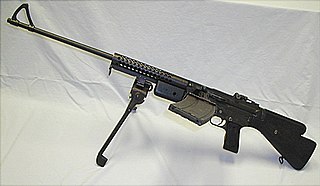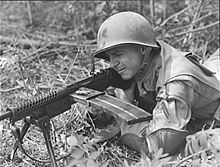Johnson M1941 (machine gun)
| Johnson M1941 | |
|---|---|
| general information | |
| Civil name: | Johnson IMG |
| Country of operation: | USA , Netherlands |
| Developer / Manufacturer: | Melvin Maynard Johnson, Cranston Arms Company |
| Manufacturer country: | United States |
| Production time: | 1941 to 1945 |
| Model variants: | M1941, M1941 / 44 |
| Weapon Category: | Machine gun |
| Furnishing | |
| Overall length: | 1066 mm |
| Weight: (unloaded) | 6.5 kg |
| Barrel length : | 558 mm |
| Technical specifications | |
| Caliber : | .30-06 Springfield |
| Possible magazine fillings : | 20 cartridges |
| Ammunition supply : | Single-row curve magazine |
| Cadence : | normal 400 - 450 rounds / min |
| Fire types: | Single and series fire |
| Number of trains : | 4th |
| Twist : | right |
| Closure : | Turret lock |
| Charging principle: | Short reverse recoil loader |
| Lists on the subject | |
The Johnson M1941 is a light machine gun that was manufactured in the United States during World War II. From 1944 a variant was produced in which the wooden piston was replaced by a piston made of the composite Micarta ; the bipod was replaced by a one-piece front support that could also serve as a fore grip.
history
The designer was Melvin Johnson, actually a lawyer and captain in the reserve of the marine infantry . He also developed the Johnson M1941 rifle , which had the same locking system. With his ambitious designs, he was of the opinion that better rifle weapons could be made available than those that were in the arsenal of the American armed forces. While his rifle couldn't compete with the M1 Garand , his ideas for a MG were more solid. The United States Army's inventory did not include a really light machine gun, the very reliable but massive Browning Automatic Rifle came closest to this category .
technology
The Johnson 1941 is a recoil loader with a short return stroke and a rotary head lock. With different buffer springs, which in addition to the recoil spring catch the return, the rate of normally 400–450 rounds / min. can be varied greatly. The weapon has a magazine feed, these hold 20 rounds; Belt feed was not provided. The magazine well is on the left side, which makes it easier to fire from cover. Due to the long magazine protruding to the left, however, the weapon is poorly balanced and turns out to be bulky when carried. The same as the German FG 42 the Johnson MG is either, depending on the fire mode aufschießend or zuschießend .
- aufschießend ( closed bolt ): at single shots . At the moment the shot is fired, the breech is in the locked state; only the firing pin moves. The weapon is more precise to fire.
- zuschießend ( open bolt ) in continuous fire. The breech is open in the rear position during pauses in fire. When the trigger is released, it snaps forward and transports a cartridge into the warehouse . The jerky movement affects the accuracy, but the more important thing here is to avoid overheating of the barrel. With the breech open, the barrel can cool; with the empty chamber, self-ignition of the ammunition ( cook offs ) is prevented.
In order to guide the recoil in a straight line to the shooter's shoulder and to limit the "climbing" of the barrel muzzle, the piston was placed in the barrel axis. For this, the rear sight and front sight had to be raised; the front sight base above the muzzle was characteristic. This arrangement of the stock and the visor was adopted two decades later by Eugene Stoner for his AR series, which resulted in the M16 . Despite its small mass and innovative properties, the Johnson MG failed to achieve great success. Only about 10,000 pieces were made, which were delivered in equal parts to the United States Marine Corps and Dutch colonial troops in Indonesia.
Israel
When the Hagana tried to procure weapons worldwide after the Israeli War of Independence , it came across an engineer in the United States who was involved in the production of the Johnson MG. He not only handed out the construction plans, but also tools for production. In Israel the weapon was copied underground as a light machine gun Dror ( Hebrew : freedom ). Since the appropriate American ammunition was missing, the MG had to be converted to the rim cartridge .303 British , which the Hagana had seized in considerable quantities. Another changeover to the German 7.92 × 57 mm Mauser took place later , but none of the variants produced many copies. The Dror MG did not prove itself in the dusty desert climate, Israel increasingly relied on arms deliveries from Czechoslovakia.
literature
- Günter Wollert, Reiner Lidschun: Infantry weapons yesterday . (1918-1945). In: Illustrated encyclopedia of infantry weapons from around the world . 3. Edition. tape 2 . Brandenburgisches Verlagshaus, Berlin 1998, ISBN 3-89488-036-8 , weapons, p. 575-576 .
Web links
- www.israeli-weapons.com: Dror (English)

